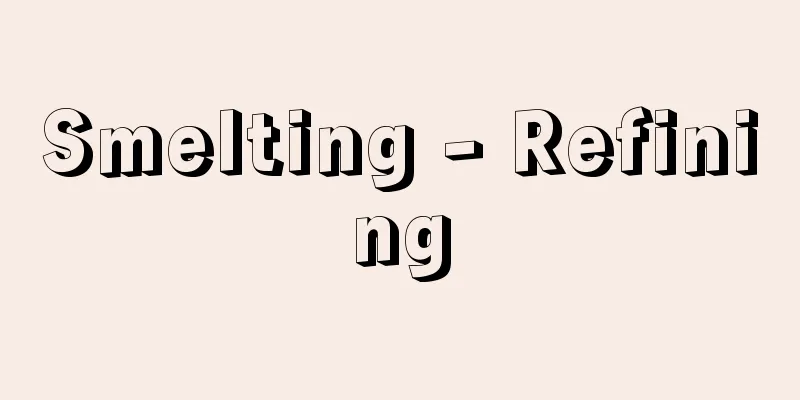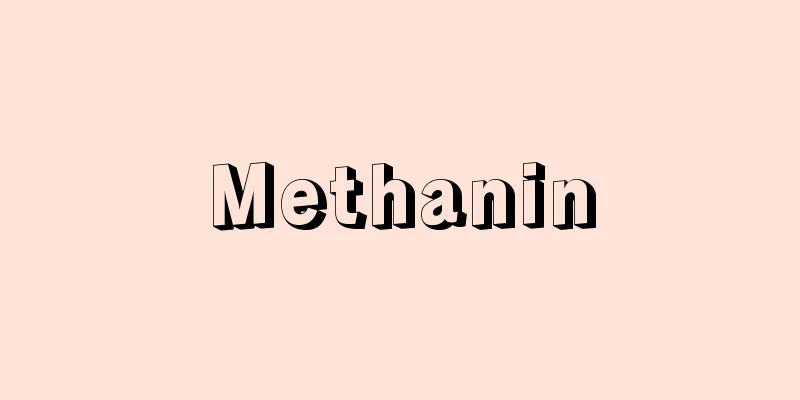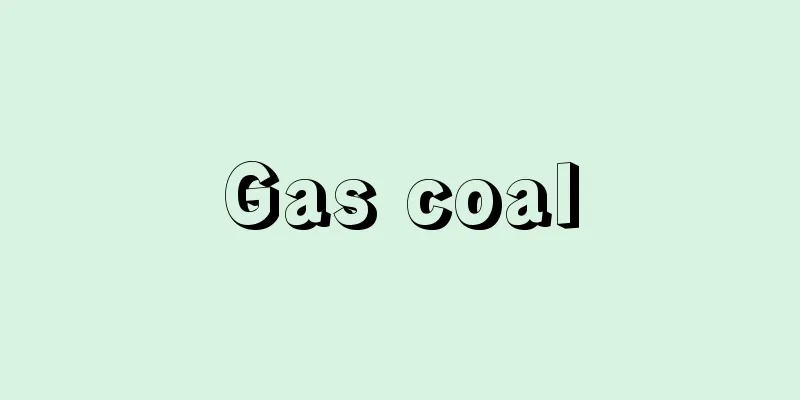Smelting - Refining

|
Smelting is the process of extracting the desired metal from rocks that contain metallic elements and producing them as metal ingots or powder. Rocks (ores) mined for the purpose of metal production contain not only valuable minerals containing the desired metal, but also useless minerals called gangue. Therefore, in the smelting process, the gangue is generally first removed from the ore to obtain the ore part (concentrate) with the highest possible content of the desired metal. This process is called ore dressing. The process of chemically treating the concentrate to obtain the desired metal is called extraction. This is the core of the smelting process, and smelting in the narrow sense refers to this process. The process of removing impurities from the extracted crude metal is called metal refining. [Hara Zenshiro] Mineral Processing and Mineral ProcessingThere are various ore-dressing methods that take advantage of the fact that the color, specific gravity, wettability, magnetism, conductivity, and other properties of minerals differ depending on the type of mineral. These include hand sorting, specific gravity sorting, heavy liquid sorting, flotation, magnetic sorting, and electrostatic sorting. Valuable minerals and gangue are finely mixed together in the ore, so the ore cannot be dressed unless it is finely divided until the two are separated into individual particles. In general, the ore is gradually divided into smaller particles using various crushing, grinding, and grinding machines, and then dressed using a method appropriate to the size of the ore at each stage. The concentrate obtained from the ore dressing process is in a muddy or powder form. To make it easier to process in the next extraction process, it is subjected to heat treatments such as drying to remove adhering moisture, calcination to remove combined moisture and gases, and roasting to change the chemical composition. The powdered ore is agglomerated by methods such as briquetting, pelletizing, and sintering. [Hara Zenshiro] Extraction of metals from concentrates (smelting in the narrow sense)Metal atoms in minerals usually combine with nonmetallic atoms to form compounds such as oxides and sulfides, and exist in an electrically positive state. The basic process of extracting metals from ores involves donating electrons to the metal atoms in some way to break the bonds with the nonmetallic atoms and turn them into an electrically neutral metallic state (reduction in the broad sense). In this process, it is also necessary to separate the nonmetallic atoms that have been broken from the bonds with the metal atoms, as well as gangue and other accompanying waste materials in the ore, from the target metal. In actual metal smelting, the following reduction methods are used depending on the type and state of the metal: (1) reduction with carbonaceous reducing agents, (2) reduction with hydrogen, (3) reduction with active metals, (4) electrolytic reduction and substitution reduction of aqueous solutions, and (5) electrolytic reduction of molten salts. Smelting carried out at high temperatures where ores or metals melt is called dry smelting (pyrometallurgy), smelting carried out at near room temperature using solvents such as aqueous solutions is called wet smelting (hydrometallurgy), and smelting using electricity is called electrosmelting (electrometallurgy). [Hara Zenshiro] PyrometallurgyThere are four types of pyrometallurgy: (1) to (4). (1) Melting using carbonaceous reducing agents Metal oxides that do not have a strong affinity for oxygen are reduced to metals by reacting with carbon monoxide or carbon at high temperatures. The smelting of iron, lead, and tin is based on this principle. Iron and tin are produced from the oxide ores hematite Fe2O3 , magnetite Fe3O4 , limonite Fe2O3.nH2O , and cassiterite SnO2 , while lead is produced from sintered ore (galena PbS) . The raw materials are smelted in blast furnaces (iron) and blast furnaces (lead) using coke as fuel, reverberatory furnaces (lead, tin) and electric furnaces (tin) using heavy oil as fuel, with coke as the reducing agent. Gangue forms molten slag together with the additive solvent, and is separated from the reduced molten crude metal. The reduction reaction in this case is generally expressed by the following formula (M is the metal): MO+CO→M+ CO2 , In practice, chalcopyrite CuFeS 2 and pyrite 2FeS・NiS are melted in a blast furnace, reverberatory furnace, electric furnace, flash furnace, etc., some of the iron sulfide is oxidized and removed as slag, and the target metals are concentrated in molten matte together with the remaining iron sulfide and separated from the slag. The matte (copper matte Cu 2 S・FeS 1.08 and nickel matte Ni 3 S 2・Cu 2 S・FeS) is transferred to a converter, where air is blown in to first combust the iron sulfide, and the resulting iron oxide is removed as slag together with added silicic acid. In copper matte smelting, air is continued to be blown into the mixture, and crude copper is obtained according to the following reaction: Cu2S (molten) + O2 (gas) The heat sources of conventional matte-producing furnaces (blast furnaces, reverberatory furnaces, electric furnaces) were coke, heavy oil or natural gas, and electricity, respectively, but in recent flash smelting furnaces, completely dried concentrate powder is ejected into the furnace together with oxygen-enriched air or hot air and combusted instantaneously, making full use of the heat generated by the oxidation of iron sulfide. Recently, a continuous copper-making process has been developed as a matte smelting process, in which the processes from matte production to blister copper production are carried out continuously. (3) Volatilization smelting method Metal compounds with high vapor pressure decompose or are reduced at high temperatures to become metal vapor. The metal can be obtained by condensing this. Mercury, zinc, and magnesium are smelted using this principle. When cinnabar (HgS), a mercury ore, is heated in air, the sulfur oxidizes and mercury vapor is generated. Mercury has been produced using this principle since ancient times. Zinc ore (ZnS), sphalerite, is first roasted to produce zinc oxide. This is then placed in a clay crucible with charcoal, sealed, and heated from below, generating zinc vapor and causing metallic zinc to condense on the inner surface of the upper part of the crucible. Zinc has been produced using this method since ancient times in China. Currently, distilled zinc is produced using a similar principle in blast furnaces and electric furnaces. (4) Active metal reduction method Metals such as uranium and titanium, which have a high affinity for oxygen and carbon, cannot be refined by reduction using carbonaceous materials. These metals are refined by first creating a halide from the oxide ore, then reducing it with an active metal such as magnesium. In the case of titanium, carbonaceous materials are first added to titanium oxide ore, and chlorine is reacted with it at high temperature to produce titanium tetrachloride ( TiCl4 , boiling point 136°C) vapor, which is separated from the gangue and condensed. Titanium tetrachloride is then fed onto a layer of molten magnesium in a reaction vessel filled with argon, and spongy metallic titanium is produced according to the following formula: TiCl4 (gas) + 2Mg(molten) HydrometallurgyIn hydrometallurgy, the target metal in the ore is dissolved (called leaching) in a suitable solvent (usually an aqueous solution, or mercury in the amalgamation process for gold and silver ores), and the metal ions in the leachate are reduced to the metal by electrolytic reduction or substitution reduction. Alternatively, a pure compound of the target metal is crystallized or precipitated from the leachate, and the metal is obtained again by some kind of reduction process. Depending on the type of ore, various solvents such as water, acid, and alkali are used for leaching, and various operating conditions are used, ranging from room temperature and pressure to heated and pressurized conditions. After the leaching operation, operations such as separation of the leachate and insoluble residue, separation of impurities from the leachate (purification), concentration of the metal ions in the leachate, and extraction of the target metal or target metal compound from the leachate are required. Some examples of hydrometallurgy are shown below. (1) Hydrometallurgy of gold and silver The main gold ore, siliceous vein ore (including argyrite Ag 2 S), is ground into slurry and the gold and silver are extracted with a dilute aqueous solution of sodium cyanide. Zinc dust is added to the leachate, and the gold and silver are precipitated and precipitated by a substitution reaction. The precipitate is then melted to obtain crude gold-silver alloy. (2) Hydrometallurgy of copper, zinc, and cadmium Roasted copper oxide ore and zinc sulfide ore are leached with sulfuric acid, and copper and zinc are extracted from the leachate (aqueous sulfate solution) by electrolysis. Cadmium that accompanies zinc ore is replaced and precipitated as metallic cadmium by adding zinc powder to the zinc leachate in the solution purification process. This is separated and collected, and refined in the same way as the hydrometallurgy of zinc. (3) Nickel hydrometallurgy Nickel is extracted from sulfide ores using ammonia and pressurized air, and from oxide ores using sulfuric acid under heating and pressure. Hydrogen is blown into the leachate under heating and pressure, and metallic nickel powder is extracted by the reduction reaction. (4) Hydrometallurgy of Aluminum Bauxite, a typical aluminum ore, is treated with a caustic soda solution under heating and pressure to extract aluminum as sodium aluminate. After separating the insoluble residue (red mud) from the leachate, it is hydrolyzed to produce high-purity alumina. This alumina is then electrolyzed in molten salt (described below) to produce metallic aluminum. (5) Hydrometallurgy of Uranium Uranium is extracted from uranium ore ( U3O8 ) using sulfuric acid. The leachate is concentrated with ion exchange and organic solvent extraction to concentrate the uranium, and then alkali is added to precipitate it as biuranate (the dried product is called yellow cake). The yellow cake is refined again using acid dissolution and organic solvent extraction to convert it into pure uranium oxide or uranium fluoride. Metallic uranium is produced by reducing uranium fluoride with metallic magnesium. [Hara Zenshiro] Electric smeltingElectricity is used as a heat source in pyrometallurgy, and electrolytic reduction is an important metal refining method. The equilibrium monoelectrode potential at which electron transfer reactions occur between the metal surface and the electrolytic bath varies depending on the metal. The ranking of metals based on the standard monoelectrode potential under certain conditions is called the galvanic series. Metals that are easy to dissolve and difficult to deposit (metals that are easy to become positive ions) have a low standard monoelectrode potential and are called less noble metals. When electrolyzing an aqueous solution of metal salts of metals that are significantly more noble than hydrogen in the galvanic series (sodium, magnesium, aluminum), reduction of hydrogen ions to hydrogen occurs at the cathode, and no reduction deposition of the metal occurs. Electrolysis of these metals must be performed using molten salt electrolysis. However, the hydrogen deposition potential at the cathode when current is actually flowing is significantly lower than the standard monoelectrode potential and is lower than the cathodic deposition potential of metals below hydrogen up to manganese in the galvanic series, so these metals can also be electrolyzed in aqueous solutions. The method of depositing and extracting metals from an electrolytic bath to a cathode using an insoluble anode is called electrowinning, and is used to extract metals from metal leachate in hydrometallurgy. An example is the hydrometallurgy of copper and zinc, in which case a lead alloy is used as the anode. The waste solution from electrowinning (sulfuric acid) is reused to extract metals from ores. A typical example of molten salt electrolysis is the electrolysis of aluminum using alumina as the raw material. The electrolytic bath is made of molten cryolite ( Na3AlF6 ) in which alumina is dissolved, and graphite is used as the electrode. [Hara Zenshiro] Metal refining from crude metalsThe process of refining crude metals to a purity sufficient for practical use is called refining. Refining methods are broadly divided into electrolytic refining and dry refining. [Azagami Takeshi] Electrolytic refiningWhen electrolysis is performed in an appropriate electrolyte solution with a crude metal as the anode and a pure metal as the cathode, the target metal dissolves from the anode and deposits on the cathode surface. Among the impurities, elements that are electrochemically more noble than the target metal do not dissolve from the anode and remain behind, while elements that are less noble than the target metal dissolve together but do not deposit on the cathode and remain in the electrolyte, and both are separated. Copper, lead, gold, silver, etc. are refined using this method. Because dissolution and deposition are reverse reactions, theoretically no power is consumed, but a small amount of power is consumed due to various electrical resistances and side reactions. [Azagami Takeshi] Dry RefiningMany methods are in practical use that exploit the differences in physical and chemical properties between the target metal and impurities. (1) Refining with oxygen, sulfur, chlorine, etc. This is the most widely used method, in which impurities are removed by reaction by adding gases or elements that are more easily combined, such as blowing oxygen into pig iron in a converter to oxidize silicon and carbon and refine it into steel. (2) Refining by distillation This is a refining method that uses the difference in boiling point between impurities and zinc, and is based on the same principle as the fractional distillation of petroleum. Crude zinc with a purity of 98% is refined to the highest purity zinc of 99.99% by this method. (3) Refining by adding a third metal When zinc is added to lead containing gold or silver, the gold and silver form compounds with the zinc and rise to the surface. The addition of aluminum to separate copper from lead works on the same principle. (4) Refining using solubility differences When the temperature of molten zinc is lowered, the lead in the zinc precipitates as a separate phase containing a large amount of lead, and this can be separated. This is a method that uses the solubility difference between the two phases, and the zone refining method used to produce ultra-high purity electronic materials is one example of this method. (5) Refining using thermal dissociation When aluminum trichloride gas is reacted with crude aluminum at high temperatures, aluminum monochloride gas is produced. When this gas is passed through a low-temperature condenser, it reverts to aluminum trichloride gas, and pure aluminum is separated and precipitated. This type of reaction is called a disproportionation reaction. [Azagami Takeshi] [Reference items] | | | |Source: Shogakukan Encyclopedia Nipponica About Encyclopedia Nipponica Information | Legend |
|
金属元素を含んでいる岩石から目的金属を抽出し、金属塊や金属粉として生産する工程を製錬という。金属生産の目的で採掘した岩石(鉱石)には、目的金属を含む有価鉱物のほかに、脈石(みゃくせき)とよばれる無用鉱物も含まれている。そこで一般に製錬工程では、まず鉱石から脈石を除いて、目的金属の含有率ができるだけ高い鉱石部分(精鉱)を得るようにしている。この工程を選鉱という。精鉱を化学的に処理して目的金属を得る工程を抽出という。これが製錬工程の中心をなし、狭義の製錬はこの工程をさす。抽出した粗金属から不純物を除去する工程を金属精製という。 [原善四郎] 選鉱および鉱石処理鉱物の色沢、比重、濡(ぬ)れ特性、磁性、誘導率などの性質が鉱物の種類によって異なることを利用して、各種の選鉱法がある。手選法、比重選鉱法、重液選鉱法、浮遊選鉱法、磁力選鉱法、静電選鉱法などである。鉱石中で有価鉱物と脈石は細かく入り混じっているから、両者がそれぞれ個別の粒子に分かれるまで鉱石を細分割しないと選鉱ができない。一般には、鉱石を各種の破砕、粉砕、磨砕機によってしだいに細分し、その各段階での鉱粒の粒度に応じた選鉱法で選鉱している。 選鉱で得た精鉱は、泥状ないし粉状である。次の抽出工程にかけやすくするため、付着水分除去のための乾燥、化合水分・気体分除去のための煆焼(かしょう)、化学成分を変化させる焙焼(ばいしょう)などの加熱処理を行う。粉鉱は団鉱法、ペレタイジング法、焼結法などの方法で塊化する。 [原善四郎] 精鉱からの金属抽出(狭義の製錬)鉱物内の金属原子は普通、非金属原子と結合して酸化物、硫化物などの化合物を形成し、電気的には正の状態で存在している。その金属原子になんらかの方法で電子を与えて非金属原子との結合を解くとともに電気的に中性な金属状態にすること(広義の還元)が、鉱石からの金属抽出工程の基本をなしている。その際、金属原子との結合を解かれた非金属原子や鉱石中の脈石その他の随伴不用物質を目的金属から分離する操作も必要である。実際の金属製錬では、金属の種類、状態に応じて、次のような還元法が採用されている。(1)炭素質還元剤による還元法、(2)水素による還元法、(3)活性金属による還元法、(4)水溶液の電解還元および置換還元法、(5)溶融塩の電解還元法、などである。鉱石・金属が溶融するような高温で行う製錬を乾式製錬(乾式冶金(やきん))、常温付近で水溶液などの溶媒を用いて行う製錬を湿式製錬(湿式冶金)、電気を利用する製錬を電気製錬(電気冶金)という。 [原善四郎] 乾式製錬乾式製錬には、以下(1)~(4)などの方法がある。 (1)炭素質還元剤を用いる溶融製錬 酸素との親和力があまり大きくない金属の酸化物は、高温で一酸化炭素や炭素と反応して金属に還元される。鉄、鉛、スズの製錬はこの原理によっている。鉄、スズは酸化鉱の赤鉄鉱Fe2O3、磁鉄鉱Fe3O4、褐鉄鉱Fe2O3・nH2O、錫石(すずいし)SnO2を、鉛は原鉱(方鉛鉱PbS)を焼結した酸化物を原料とし、コークスを燃料とした高炉(鉄)や溶鉱炉(鉛)、重油燃料の反射炉(鉛、スズ)や電気炉(スズ)で、コークスを還元剤として製錬する。脈石は添加溶剤とともに溶融スラグを形成して、還元された溶融粗金属から分離される。この場合の還元反応は一般的には次式で示される(Mが金属)。 MO+CO→M+CO2, 実際には、黄銅鉱CuFeS2、硫鉄ニッケル鉱2FeS・NiSをそれぞれ、溶鉱炉、反射炉、電気炉、自溶炉などで溶融し、硫化鉄の一部は酸化しスラグとして排除し、目的金属は残存硫化鉄とともに溶融マットに濃縮してスラグから分離する。マット(銅マットCu2S・FeS1.08、ニッケルマットNi3S2・Cu2S・FeS)は転炉に移し、空気を吹き込んでまず硫化鉄を燃焼させ、生成する酸化鉄を添加ケイ酸とともにスラグとして排除する。 銅のマット製錬では、さらに空気吹き込みを続け、次式の反応で粗銅を得る。 Cu2S(融)+O2(気) 在来のマット生成炉(溶鉱炉、反射炉、電気炉)の熱源は、それぞれコークス、重油または天然ガス、電熱であったが、近年の自溶炉では、完全乾燥した精鉱粉を酸素富化空気ないし熱風とともに炉内に噴出して瞬間的に燃焼させることにより、硫化鉄の酸化発熱を十分に活用している。マット製錬法による製銅炉として、最近、マット生成から粗銅生成までの工程を連続的に行う連続製銅法が開発されている。 (3)揮発製錬法 蒸気圧の大きい金属の化合物は高温で分解あるいは還元によって金属蒸気となる。それを凝縮すれば金属が得られる。水銀、亜鉛、マグネシウムはこの原理で製錬される。水銀鉱石の辰砂(しんしゃ)HgSは空気中の加熱で硫黄(いおう)が酸化し、水銀蒸気が発生する。古くからこの原理で水銀が生産されていた。亜鉛鉱石の閃(せん)亜鉛鉱ZnSはまず焙焼して酸化亜鉛とする。ついでこれを木炭とともに素焼るつぼに装入・密封し、下方から加熱すると、亜鉛蒸気が発生し、るつぼ上部内面に金属亜鉛が凝縮する。中国では古くからこの方法で亜鉛を生産していた。現在は、溶鉱炉や電熱炉により同様の原理で蒸留亜鉛が生産されている。 (4)活性金属還元法 ウラン、チタンなどの酸素、炭素との親和力の大きい金属は炭素質による還元法では製錬できない。これらの金属は酸化物原鉱からいったんハロゲン化物をつくり、それをマグネシウムなどの活性金属で還元するという方法で製錬される。チタンの場合は、まず酸化チタン鉱に炭素質を加え、高温で塩素を作用させて生成する四塩化チタン(TiCl4、沸点136℃)の蒸気を脈石から分離し、凝縮させる。ついでアルゴンを満たした反応容器内の溶融マグネシウム層上に四塩化チタンを供給すると、次式により海綿状の金属チタンが生成する。 TiCl4(気) + 2Mg(融) 湿式製錬湿式製錬では、鉱石中の目的金属を適当な溶媒(一般には水溶液、金・銀鉱のアマルガム製錬法では水銀)で溶かし出し(浸出という)、浸出液中の金属イオンを電解還元や置換還元法で金属に還元する。あるいは浸出液から目的金属の純化合物を晶出、沈殿させ、ふたたびなんらかの還元処理で金属を得る。浸出には、鉱石の種類により、水、酸、アルカリなど各種の溶媒が、常温・常圧から加温・加圧まで各種の操作条件で使用される。浸出操作後、浸出液と不溶解残滓(ざんし)の分離、浸出液から不純物の分離(浄化)、浸出液中の金属イオンの濃縮、浸出液からの目的金属ないし目的金属化合物の採取などの操作が必要である。湿式製錬のいくつかの例を次に示す。 (1)金・銀の湿式製錬 主要な金鉱石であるケイ酸質脈状鉱石(輝銀鉱Ag2Sも含む)は磨砕して泥化し、シアン化ソーダ希薄水溶液で金・銀を浸出する。浸出液に亜鉛末を加え、置換反応で金・銀を析出・沈殿させ、沈殿物を溶融して金・銀合金の粗金属を得る。 (2)銅、亜鉛、カドミウムの湿式製錬 銅酸化鉱、亜鉛硫化鉱の焙焼鉱は、硫酸でそれぞれ金属を浸出し、浸出液(硫酸塩水溶液)から銅、亜鉛をそれぞれ電解採取する。亜鉛原鉱中に随伴するカドミウムは、浄液工程で亜鉛浸出液に亜鉛粉末を加えることにより金属カドミウムとして置換・析出するので、これを分離・捕集し、亜鉛の湿式製錬法と同様の方法により精製する。 (3)ニッケルの湿式製錬 硫化鉱からはアンモニアと加圧空気で、酸化鉱からは硫酸で、それぞれ加温・加圧下でニッケルを浸出する方法が実用されている。浸出液に加温・加圧条件下で水素を吹き込み、その還元作用で金属ニッケル粉を採取している。 (4)アルミニウムの湿式製錬 代表的なアルミニウム鉱石であるボーキサイトには、加温・加圧下でカ性ソーダ水溶液を作用させ、アルミニウムをアルミン酸ナトリウムとして浸出する。浸出液は不溶解残滓(赤泥)を分離したのち、加水分解して高純度アルミナとする。このアルミナを溶融塩電解(後述)して金属アルミニウムを生産する。 (5)ウランの湿式製錬 ウランの主要鉱石である瀝青(れきせい)ウラン鉱U3O8は硫酸によってウランを浸出する。浸出液はイオン交換法や有機溶媒抽出法によってウランを濃縮したのち、アルカリを加えて重ウラン酸塩として沈殿させる(その乾燥物がイエローケーキ)。イエローケーキはふたたび酸溶解有機溶媒抽出法によって精製し、純酸化ウランやフッ化ウランに変える。金属ウランはフッ化ウランを金属マグネシウムで還元して生産する。 [原善四郎] 電気製錬電気は電熱として乾式製錬の熱源に利用されるが、電解還元法は重要な金属製錬法である。金属表面で電解浴との電子の授受反応が生ずる平衡単極電位は、金属によって異なる。一定条件下の標準単極電位によって金属につけた順位を電位列とよぶ。溶解しやすく析出しにくい金属(正イオンになりやすい金属)は標準単極電位が低く、卑な金属とよばれる。電位列で水素よりも著しく卑な金属(ナトリウム、マグネシウム、アルミニウム)の金属塩水溶液を電解すると、陰極で水素イオンから水素への還元が生じて金属の還元析出は生じない。これらの金属の電解は溶融塩電解によらざるをえない。ただし、実際に電流が流れている状態での陰極における水素析出電位は、標準単極電位よりも著しく低くなり、電位列で水素以下マンガンまでの金属の陰極析出電位よりも低くなるため、これらの金属も水溶液電解が可能である。 不溶性陽極を用いて電解浴から陰極に金属を析出・採取する方法を電解採取といい、湿式製錬における金属浸出液からの金属採取に利用される。銅、亜鉛の湿式製錬がその例で、この場合、陽極には鉛合金を用いる。電解採取の廃液(硫酸)は、鉱石からの金属浸出に繰り返し使用する。 溶解塩電解の代表例はアルミナを原料とするアルミニウムの電解である。アルミナを溶解させた溶融氷晶石Na3AlF6を電解浴とし、黒鉛を電極とする。 [原善四郎] 粗金属からの金属精錬粗金属を実用に十分な純度にまで精製する操作を精錬という。精製法は、電解精製と乾式精製とに大別される。 [阿座上竹四] 電解精製粗金属を陽極とし、純金属を陰極として適当な電解質溶液中で電解すると、陽極から目的金属が溶け出し、陰極面上に析出する。不純物のうち、目的金属より電気化学的に貴な元素は陽極から溶け出さずに残留し、目的金属より卑な元素はいっしょに溶け出すものの陰極には析出せず、電解液中に残って、いずれも分離される。銅、鉛、金、銀などはこの方法で精製されている。溶出と析出は逆反応であるため、電力消費は理論的にはゼロであるが、種々の電気抵抗や副反応のため少量の電力を消費する。 [阿座上竹四] 乾式精製目的金属と不純物の間の物理的・化学的性質の差を利用した多くの方法が実用されている。 (1)酸素・硫黄・塩素などによる精製 たとえば転炉中で銑鉄に酸素を吹き込んでシリコンや炭素を酸化し、鋼に精製するように、不純物がより化合しやすいガスや元素を加えて反応除去する方法で、もっとも広く行われる。 (2)蒸留による精製 不純物との沸点の差を用いる精製法で、石油の分留と同じ原理による。純度98%の粗亜鉛はこの方法で99.99%の最純亜鉛に精製される。 (3)第三金属の添加による精製 金・銀を含む鉛に亜鉛を加えると、金・銀は亜鉛と化合物をつくって表面に浮き上がる。鉛中の銅を分離するのにアルミニウムを加えるのも同じ原理によるものである。 (4)溶解度差を利用する精製 亜鉛中の鉛は、溶融亜鉛の温度を下げると鉛を多く含む別相をつくって沈降するので、これを分離することができる。これは二つの相の間の溶解度差を利用する方法で、超高純度の電子材料をつくるのに用いるゾーン精製法もこの一種である。 (5)熱解離を利用する精製 粗アルミニウムに三塩化アルミニウムガスを高温で作用させると、一塩化アルミニウムガスを生ずる。これを低温のコンデンサーに導くとふたたび三塩化アルミニウムガスに戻り、純アルミニウムを分離析出する。この種の反応を不均化disproportionation反応とよぶ。 [阿座上竹四] [参照項目] | | | |出典 小学館 日本大百科全書(ニッポニカ)日本大百科全書(ニッポニカ)について 情報 | 凡例 |
>>: Seiren - Seiren (English spelling)
Recommend
Well replacement - Idogae
Draining all the water from a well and cleaning it...
Sue [village] - Sue
A village in Kuma District, southeastern Kumamoto ...
Relative Death - Aitaiji ni
A legal term for love suicide and double suicide ...
Ship Lessee - Demise Charterer
A bareboat charterer is a person who, in a broad s...
Iranian Heavy - Iranian Heavy
…The porosity is extremely small at 8-10%, but th...
Condenser - condenser
A device for liquefying gas. When only a single s...
Aekuni Shrine
It is located in Ichinomiya, Iga City, Mie Prefec...
Alloway, L.
...The name "Pop Art" is said to have o...
jeu de mail (English spelling)
…However, the birthplace of hockey is believed to...
Nara version - Naran
[Noun] This is a general term for the editions pub...
Frank, T. (English spelling) FrankT
...The use of natural science methods from the la...
Owari Hamanushi - The End of Hamanushi
A gagaku musician from the early Heian period. He...
Guo Zi Xuan - Hidden Gen
…A thinker from the Western Jin Dynasty in China....
Hakatabushi - Hakatabushi
〘Noun〙 A type of folk song. It is a song sung in t...
Braided cord - Kumihimo
It refers to a string made of one or more threads...









